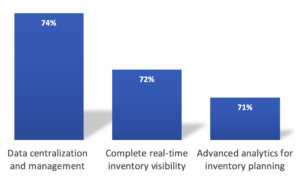SAPinsider will publish a benchmark report on
Inventory Management and Optimization in November 2022. There could not have been a better time to conduct research focused only on inventory management and optimization. Why so? Well, the first aspect, which is not surprising to any of us, is the immense focus on supply chain and inventory management that we have seen in the last couple of years. As it applies to critical industries, inventory management is even being discussed in the
White House. So that provides an excellent opportunity to explore this topic, to get more insights on this topic for executives so that they can leverage that to harness the energy that has built around transforming inventory management, put it to better use for getting funding, through getting business cases approved and, using that energy positive momentum to transform their inventory management process. In this article, we will explore an exciting insight that has emerged from the survey responses for the research that we have received so far. We will explore why SAPinsiders believe effective data management is key to developing robust inventory management capabilities.
As we analyze responses from hundreds of SAPinsiders across the globe who took our survey, one key aspect that has emerged is the attention to effective data management as a foundation for developing robust inventory management and planning capabilities. As supply chains become increasingly complex, so does the associated data landscape. Millions of data points must be managed in modern supply chains today because of the wide gamut of systems used. From Enterprise resource planning (ERP) systems that manage an organization’s basic processes to customer relationship (CRM) systems that handle contacts with present or future customers, the gamut of systems that create or manage data is broad. Without a single source of truth, each of these systems could have various versions of the same data element, making cross-departmental collaboration difficult and risky. With so many data silos, many versions of data, and inaccuracies from manual entries and erroneous data, this problem will only worsen until a solution that uses a single source of truth to improve data quality is implemented. And all this holds for inventory management, and we saw that in the survey responses.
As shown in figure 1, improving inventory data quality and accuracy emerged in the top three strategies that SAPinsiders are planning to address their business drivers,
precisely, the need to address supply chain uncertainties, product portfolio and footprint complexities, and an explosion in the data being generated and captured. It is not surprising to see improving data quality and accuracy as one strategy to address these drivers, since holding inventory itself aims to address supply chain uncertainties. That is why safety stock calculations incorporate the standard deviation of historical demand. Inventory is a buffer to handle uncertainty; your capability to manage supply chain uncertainties dwindles if you do not have the correct visibility into that buffer. And hence effective data management is critical for robust inventory management.

But there is another layer to data quality and integrity. That aspect emerged in the top three requirements that SAPinsiders highlighted they need to work on helping execute their strategy. As shown in figure 2, the top requirement is to centralize and harmonize the inventory data into one source of truth.

As you can see from the figure above, the other two requirements are also essentially dependent on the robustness of data management. Accurate visibility requires prime data quality and integration. For analytics, we have the principle of "garbage-in-garbage-out", so bad-quality data can make the best of analytics tools ineffective.
 But there is another layer to data quality and integrity. That aspect emerged in the top three requirements that SAPinsiders highlighted they need to work on helping execute their strategy. As shown in figure 2, the top requirement is to centralize and harmonize the inventory data into one source of truth.
But there is another layer to data quality and integrity. That aspect emerged in the top three requirements that SAPinsiders highlighted they need to work on helping execute their strategy. As shown in figure 2, the top requirement is to centralize and harmonize the inventory data into one source of truth.
 As you can see from the figure above, the other two requirements are also essentially dependent on the robustness of data management. Accurate visibility requires prime data quality and integration. For analytics, we have the principle of "garbage-in-garbage-out", so bad-quality data can make the best of analytics tools ineffective.
As you can see from the figure above, the other two requirements are also essentially dependent on the robustness of data management. Accurate visibility requires prime data quality and integration. For analytics, we have the principle of "garbage-in-garbage-out", so bad-quality data can make the best of analytics tools ineffective.







